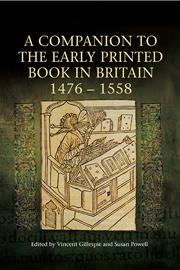Book contents
- Frontmatter
- Contents
- List of Illustrations
- List of Contributors
- Preface
- Acknowledgements
- Abbreviations
- Chronology of the Period
- Introduction
- I THE PRINTED BOOK TRADE
- II THE PRINTED BOOK AS ARTEFACT
- 4 Materials: Paper and Type
- 5 Bookbinding and Early Printing in England
- 6 Woodcuts and Decorative Techniques
- III PATRONS, PURCHASERS AND PRODUCTS
- IV THE CULTURAL CAPITAL OF PRINT
- Index of Manuscripts
- Index of Printed Books
- General Index
5 - Bookbinding and Early Printing in England
from II - THE PRINTED BOOK AS ARTEFACT
Published online by Cambridge University Press: 05 April 2014
- Frontmatter
- Contents
- List of Illustrations
- List of Contributors
- Preface
- Acknowledgements
- Abbreviations
- Chronology of the Period
- Introduction
- I THE PRINTED BOOK TRADE
- II THE PRINTED BOOK AS ARTEFACT
- 4 Materials: Paper and Type
- 5 Bookbinding and Early Printing in England
- 6 Woodcuts and Decorative Techniques
- III PATRONS, PURCHASERS AND PRODUCTS
- IV THE CULTURAL CAPITAL OF PRINT
- Index of Manuscripts
- Index of Printed Books
- General Index
Summary
From the time of the arrival of the first printed books up to the Reformation many different kinds of bindings were used on early English books. To a greater extent than has been previously suggested, the story of the early printed English book is a story about these bindings: about the men and women who bound them and continuity in their craft and business practice before and after printing; and about the changes wrought by print upon the structure of the English codex and the uses to which it was put.
This discussion begins with some examples: bindings on three of the earliest surviving English printed books. Several copies of William Caxton's 1478 edition of Chaucer's Boece (STC 3199) survive in their earliest bindings. One of these is now in the library at Magdalen College, Oxford. It is a Sammelband: soon after it was acquired it was bound together with an incomplete copy of the Latin text of Boethius's Consolatio philosophiae printed by Johann Koelhoff in Cologne in 1481 (Boethius's text is intact, but gatherings containing a commentary by pseudo-Aquinas are missing). The two books have been bound together between two bevelled and cushioned oak boards; these have been covered in a dyed and whittawed sheepskin which is now very faded, so that the original green colour of the cover is visible only on the turn-ins. The sewing supports are laced into straight channels and secured with wooden pegs. The book bears the remains of two fastenings: hook clasps on short red leather straps that closed to the lower board. It has endbands of leather (see Figures 5.1, 5.2 and 5.3).
- Type
- Chapter
- Information
- Publisher: Boydell & BrewerPrint publication year: 2014

